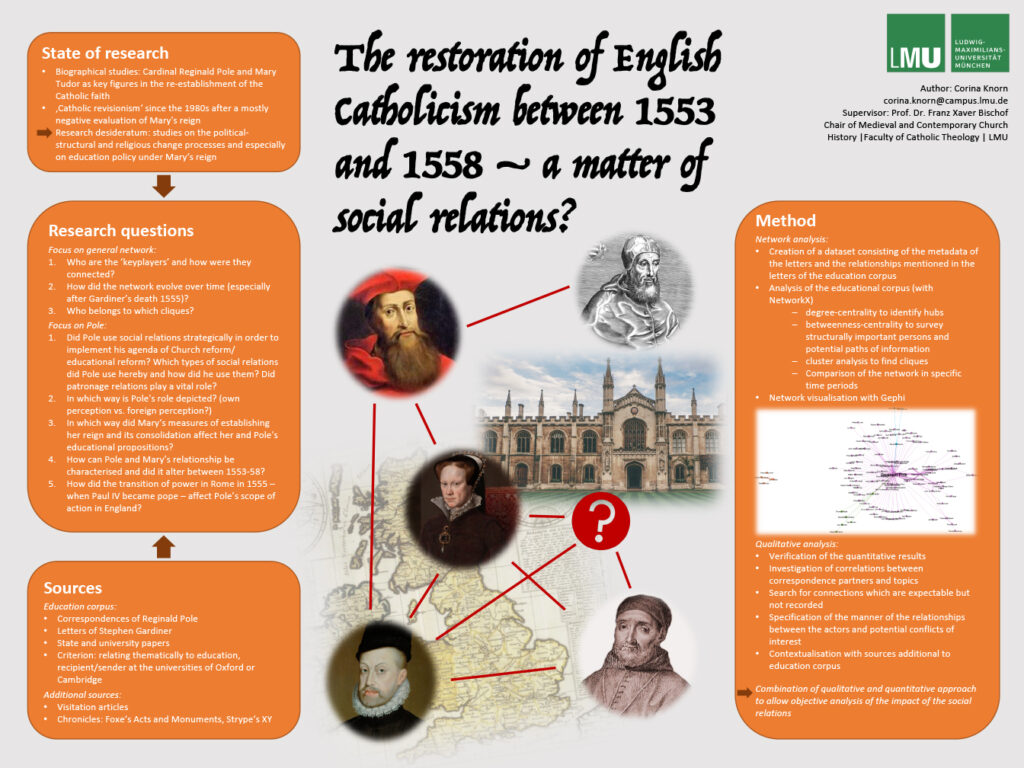Corina Knorn
Time and Place: Thursday, 01.07., 16:00–17:00, Room 1
Session: Poster Session – Institutions and Institutionalisation
Keywords: English Reformations; Reginald Pole; Historical network analysis
Within the era of Counterreformation between 1553 and 1558, Mary Tudor and Reginald Pole can be pointed out as the key players of restoring Catholic faith in England according to current research.1 Especially Pole is considered as the ‘architect’ of Marian Catholicism: He was appointed legate by Pope Julius III and granted ample powers in order to restore Catholicism in England. In 1556, he became Archbishop of Canterbury as well as chancellor of the universities of Oxford and Cambridge which naturally enlarged Pole’s scope of action. On top of that, he had a ramified web of relations at his disposal which he had carefully built during his time abroad in Padua, Trent and Viterbo. By the time he arrived in England in 1554, he seems to have established his position right in the heart of a multiplex network of relations to rulers like Mary, Charles V and Henry II of France, to popes, friends and companions such as Giovanni Morone, Bartolomé Carranza and Pedro de Soto as well as fellow countrymen and his relatives. This is particularly interesting to examine with regard to the potential paths of information and influence provided by the network. However, reciprocal and multidimensional relations do not necessarily only increase one’s scope of action but partially restrict it. Hereby, the question of pursuing personal interests while remaining loyal to the crown becomes highly volatile. According to the decrees of the legatine synod of 1556, Pole and Mary aimed among others at the provision of well-educated priests to the local parishes.2 This required a better qualification of the clergy and a reform of the universities. The impact of Pole’s relations becomes especially worth examining regarding the personnel policy in Oxford and Cambridge: apart from being chancellor himself after 1556, like-minded people and friends such as the Spanish Dominicans Carranza and de Soto were installed as lecturers or fellows at the colleges in order to ensure the ‘old faith’ and enhance the reform plans. Moreover, several protégés and former Oxford-men were anointed as bishops.
To sum up, analysing the manner of Pole’s interactions with his contemporaries for instance regarding their type of relation and clique-membership will provide a deeper understanding of micropolitics in Marian England. For this purpose, all actors and relations based on Pole’s correspondences3 between August 1553 and November 1558 will be recorded in a relational database in order to create a visualisation of his network. This quantitative approach will be combined with a close reading of the letters. On the level of macropolitics, examining Pole’s social embedding and its impact on his actions regarding the restoration of Catholicism will therefore offer new perspectives on manner and success/failure of Church reform in England under Mary’s reign.
1 See for example Duffy, Eamon, Fires of Faith, New Haven 2009; Marshall, Peter, Heretics and Believers, New Haven 2017; Mayer, Thomas F., Reginald Pole. Prince & Prophet, Cambridge 2000; Edwards, John, Archbishop Pole, Aldershot 2014.
2 See Can. 4 and 11, The Legatine Constitutions of Cardinal Pole 1556, quoted after Bray, Gerald (ed.), The Anglican Canons, Woodbridge 1998.
3 See Mayer, Thomas F. (ed.), The Correspondences of Reginald Pole, 4 vols., Aldershot 2002-2008.
